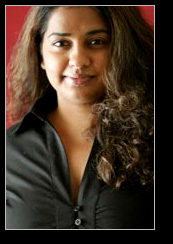
Susanne Fosse: You studied at University of California, Berkeley which has produced some excellent filmmakers Errol Morris (The Thin Blue Line) and Carl Franklin (One false Move). Why did you want to begin working in film?
Neeta Mittal : Oh yes! The Berkeley alums that showed the way! Well, for me it has always been a tug between the left and the right sides of the brain. I decided that Entertainment business would serve both, in a sense. I joined the film fraternity to understand the business of movie making. In the process I got involved in the creative. Because of my previous experience as a dancer, and dance and fashion choreographer, I decided to explore the voices from the right hemisphere by enrolling in a directing class. The 3-minute film deliverable took a life of its own. And “Wings of Legacy” was made. I think the left brain has now made peace with the right.
top
Susanne Fosse: "Wings of Legacy" is a wonderful debut short film for a director. What inspired the idea for the story?
Neeta Mittal :I find it amusing to juxtapose two conflicting ideas and visualize what could come out of it. In “Wings of Legacy”, I thought it will be interesting to juxtapose something as fluid as dance with something that is perceived as inhibiting, such as a wheelchair. You have a conflict right there. My love for dance had a lot to do with the subject matter as well. When I met with Auti Angel, who plays Amy, I decided to make a film that does not concentrate on the disability. I refused to depict the disabled character as a hero or as a pathetic victim as is usually done in narrative form of filmmaking. I wanted the wheelchair to be just a physical trait and I wanted the character to have real human flaws.
top
Susanne Fosse: There have been many films recently like Take the Lead (Hip Hop & Ballroom) and Save the Last Dance (Hip Hop and Ballet) which have combined dance styles on film. How did your film approach those fusions in your film?
Neeta Mittal :The character of Amy, the disabled dancer, starts out as over-confident with a lot of unbridled energy. To ensure that the wheelchair did not take that away, I decided to make the wheelchair hip and cool…hence the hip hop. Hip hop is raw force. Later on, Amy’s character needed to transition into a responsible prodigy. That required supplementing the character arc with a transition in dance style. Ballet puts great emphasis on the method and execution of movement. The transformation from Hip-hop to Ballet was very dramatic. In short, Hip-hop and Ballet were chosen as motifs to represent the contradictory entities of youth and wisdom, ability and disability, life and death.
top
Susanne Fosse: There is a wonderful sub-heading for the film "Disability meets ability and death meets life". Can you explain that?
Neeta Mittal : Amy loves to show off in her rocking wheelchair. She is over confident and almost disrespectful. Her real disability is her bad attitude. In Eva, the ballet teacher, she finds a mentor. On the other hand, Eva is battling leukemia. But it is not her imminent death, but the end of her legacy, that is disheartening her. That is when she meets Amy. She sees in Amy the fire and passion to give flight to her legacy.
top
Susanne Fosse: Amy is played by Auti Angel, a wheelchair dancer who in real
life lost the use of her legs. How did the casting for the film
take shape after it was written?
Neeta Mittal :The idea, initially, was to cast an able-bodied actress for the lead and then to train her to dance in a wheelchair. I approached a lot of casting agencies, one of them being Media Access, Auti Angel's agency. When the agency suggested Auti’s name, I was a bit apprehensive. The notion of a girl in a wheelchair who could dance was alien to me. However, Auti fit the role at many levels. She was a hip hop dancer before (and after) her accident, she adapted to various dance styles easily and she had the “punch” to make the character interesting. Many have asked if I wrote the story after meeting Auti; it is just that she was meant to play the role.
top
Susanne Fosse: The finale dance numbers are played out against a full auditorium. How did you and your cinematographer Andrew Waruzewski approach shooting those scenes?
Neeta Mittal : Well, we cheated. We shot the grand finale in an almost empty auditorium. For a few shots, we filled just one section with parents, relatives, crew, and theatre staff. After the last day of the shoot at another location, we rushed back to the theater when a musical was playing to a packed audience. We walked out on the stage, about 15 mins before they were due to start the musical, and requested the audience if we could film them. The audience was gracious enough to comply. Auti performed a few maneuvers without music. The audience’s applause was genuine and not staged. I give full credit to the DP for matching the light and to the makeup artist for the very accurate recreation of Auti’s hairdo and make up.
top
Susanne Fosse: What are you working on next?
Neeta Mittal : My company is in pre-production for a short film that I will direct in the first week of March. I am also in the process of acquiring finances for a feature film. It is a romantic comedy about a young woman’s adventures with the Kama Sutra. I am exploring possibilities of a UK-Canada Treaty co-production or a UK-Canada-India Treaty co-production.
top
|